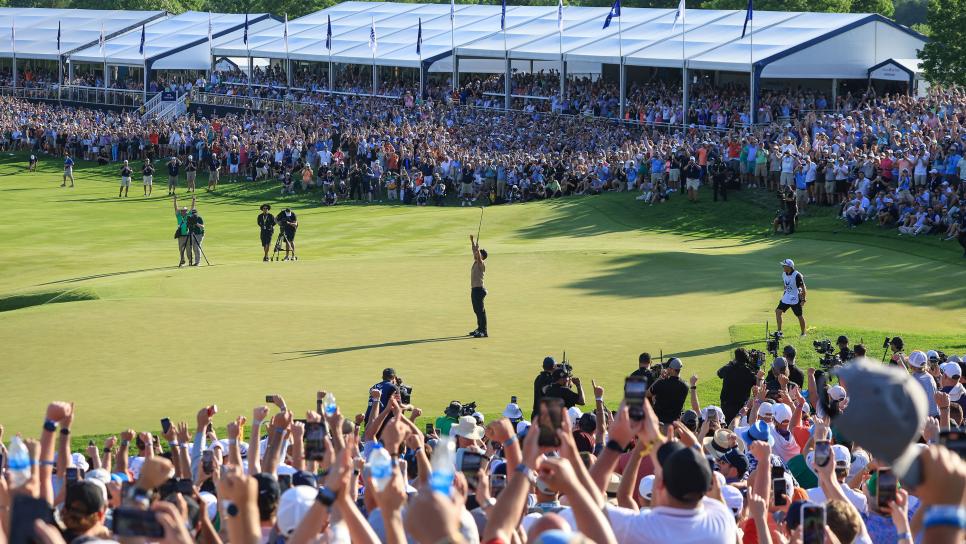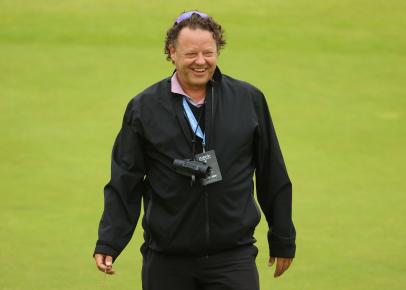Voices
Why an 'exciting' major and a 'good' major are two different things

What kind of golf is best for major championships?
It’s not a new question, although it wasn’t that long ago that a fitting answer would have been, “Well, isn’t it obvious?!?” But with Xander Schauffele shattering the 72-hole scoring records at a major in a thrilling finish at Valhalla, things have become more interesting. There are more elements at play in golf’s current ecosystem, and perhaps a reconsideration is in order.
Traditionally, fast-and-firm conditions—with a steady breeze as a bonus—have been the sought after ideal for major championships. Setups that make par a valued score, and present a challenge designed to reward the most complete player. The principles the USGA has incorporated with the U.S. Open, which has always prided itself on being the toughest major, was built on.
Of course, since switching the PGA Championship from match play to stroke play in 1958, the PGA of America has employed a softer approach to set-ups at its signature event could be described as U.S. Open-lite. The higher rate of birdies and low scores, once looked on as a reason the PGA unofficially ranks fourth in prestige among the majors, could become a positive in golf’s changing landscape. It all depends on what the beholder values. Here’s the case for each.
When a championship course plays fast and firm, it becomes more difficult to control where the ball ends up. Off the tee, the increased bounce and roll of ball can more easily send it off the fairway and into trouble. That affords those players who can bend their drives to best fit each hole a way to find more short grass.
On approach shots, a firm green makes it more difficult to stop the ball in the intended spot. Hitting the proper landing area is vital, and a player’s ability to properly shape an iron shot can result in using the contours of a firm green to his advantage. The tighter turf also puts a premium on a solid strike. Mishits will generally result in a shot that does not hold, or lands in a place that takes if farther away from the hole.
Especially around a firm green, the highest degree of contact, variety and finesse is required on chips and pitches to keep saving par. Putting requires more touch and nerve on faster surfaces, especially those with undulation, as second putts tend to be longer and three-putting a constant fear.
Simply, faster and firmer setups demand more good golf. On occasion, both the USGA and the R&A have tried too hard to ensure that demand in their championships and pushed some setups into unfairness. But even on their fairest setups, the imposed difficulty can dictate defensive play, where avoiding bogeys is more important than trying for birdies. It’s how Ben Hogan and Jack Nicklaus each won four U.S. Opens. But to some tastes, and maybe a number that’s increasing, it’s too much of a slog.
Especially at the PGA among the majors, when a course design is relatively easy, or the weather turns wet, the already more permissive setup becomes noticeably vulnerable. In general, with less roll, fairways become effectively wider, and the demand to work the ball in different directions is lessened or eliminated. With more margin for error, the emphasis moves from cautious accuracy to maximized carry.
Similarly, into softer or more receptive greens, hitting straight shots at the pin carries less risk than into a fast and firm green. It’s an almost exclusively aerial game, with little concern for what the ball will do after it lands, other than perhaps spin back too much. The result is more shots landing and staying close to the pin. Balls that miss the green do not bounce as far away, so short-game recovery is easier. And on slower greens, bolder putting is easier to summon. It all promotes offensive golf, producing more birdies and fewer bogeys, and lower scores.
Valhalla, more than any recent major, had these conditions. When it was assaulted by the modern power game, it surrendered the lowest total and under-par winning score in major championship history, and very nearly the first major championship 61 (by Shane Lowry). According to stats guru Justin Ray, Valhalla produced the lowest combined score by the field in a major—214 under par—shattering the previous low of 40 over par at the 1995 PGA at Riviera. We’ll do the math for you: that’s 255 shots lower.
There’s not much question that fast and firm asks for higher quality golf. It places a greater demand on skill, nerve and temperament. The most revered major-championship performances in history have been achieved in fast-and-firm conditions.
But the question remains, are the higher scores and more conservative strategy what today’s golf fans want to see and today’s players want to play? Is it the best golf for major championships? Because there are some advantages to softer conditions. With the skill demands on players lessened, more of them can handle the test at hand, causing fields to stay more closely bunched. That often leads to more players in contention on Sunday, increasing the chance of a crowded stretch run and a more thrilling finish.

Soft conditions at Valhalla allowed players to be much more aggressive off the tee and into greens, with little fear of big numbers if they made a mistake.
David Cannon
Conversely, less forgiving fast-and-firm conditions usually see more players fall away from the leaders, as mediocre or poor play is more severely punished. Fewer competitors able to hang near the top creates runaways by the more highly skilled players finding their “A” games at just the right time. Think young Jack at the 1965 Masters, or Tiger at Augusta in 1997 or Pebble Beach in 2000. Those moments can be regarded as virtuosic, but some bemoan them as lacking drama, or even boring.
On a softer setup, especially one softened by rain like Valhalla was, such virtuosity is more readily attained. With an increased margin for error, players were freed up to try more full bore shots at the very limits of their athletic talent, exemplified by Bryson DeChambeau’s 220-yard 8-iron approach to three feet on the 70th hole followed by a 196 mph ball-speed tee shot on the 71st. And the moments were intensified because DeChambeau was in a dog fight with Schauffele and Viktor Hovland.
So it was at Valhalla, a style that can be celebrated as exceptional entertainment, or dumbed down tournament golf. The casual and new fan to the game is more likely to see it as the former, the purist/traditionalist, who until recently has held sway, might lean toward the latter. But there isn’t much disagreement about which way the pendulum is moving.
With the current fracture in professional golf, the term “product” is now routinely used to describe the PGA Tour and even the major championships. The commercial urgencies have made it depressingly necessary to reduce the highest level of the game to another striving competitor in the entertainment business. It always has been, of course, but the sheer mastery required to shoot the lowest score was considered entertainment enough. But I fear that the need to hype a suddenly insecure pro game means that setups, even at the majors, will bow to the attention seemingly paid to distance and easy birdies.
Or maybe this is just an afficionado’s precious argument about aesthetics. What happened at Valhalla doesn’t have to be a signal of decadence. Regardless of the style of play allowed, the best golfers in the world were still trying to shoot the lowest scores possible. And by the way, in the end Schauffele still had to go old school, closing with a nervy pitch and a gutted-out six-footer.

En route to victory, Xander Schauffele set the 72-hole score record for a major championship, thrilling the Valhalla crowds in the process.
Darren Carroll/PGA of America
Let me close with a modest pitch. The majors exist for the best to show why they are the best. The difficulty is the point. Don’t cheapen the challenge. As a counter to distance and equipment optimization, the majors should err toward harder, not easier set ups.
In the words of the legendary Charles Price: “Ordinary golf … is like walking a tightrope when it’s just off the ground. Tournament golf is when they raise the rope to 60 feet. Championship golf is when they take the net away.”
Valhalla had a net. Give me more artistry and skill—more Scottie Scheffler. Golf, at the very highest level, has more of it than any other sport. Which is the best claim it has to being the greatest game of all.


